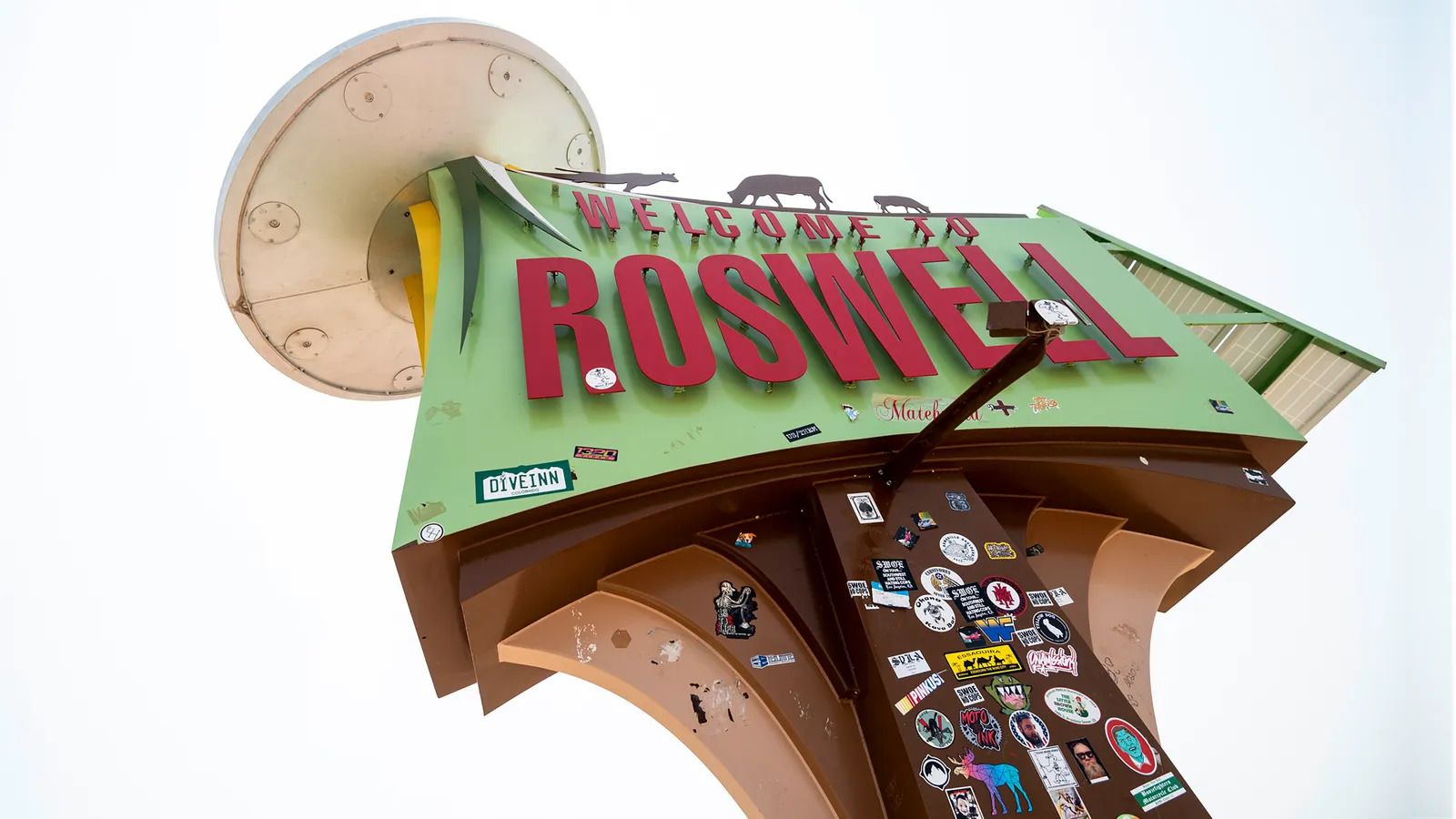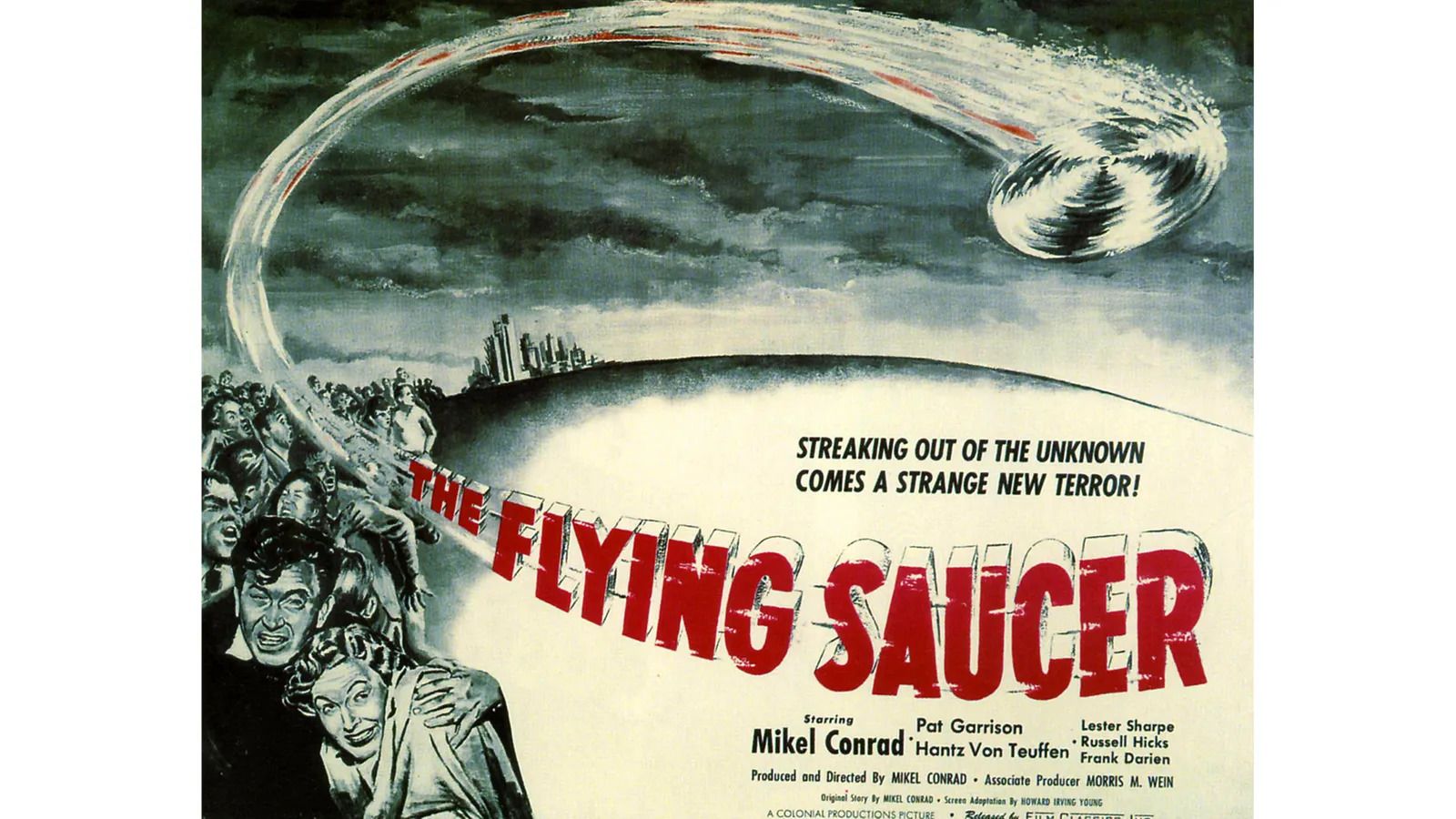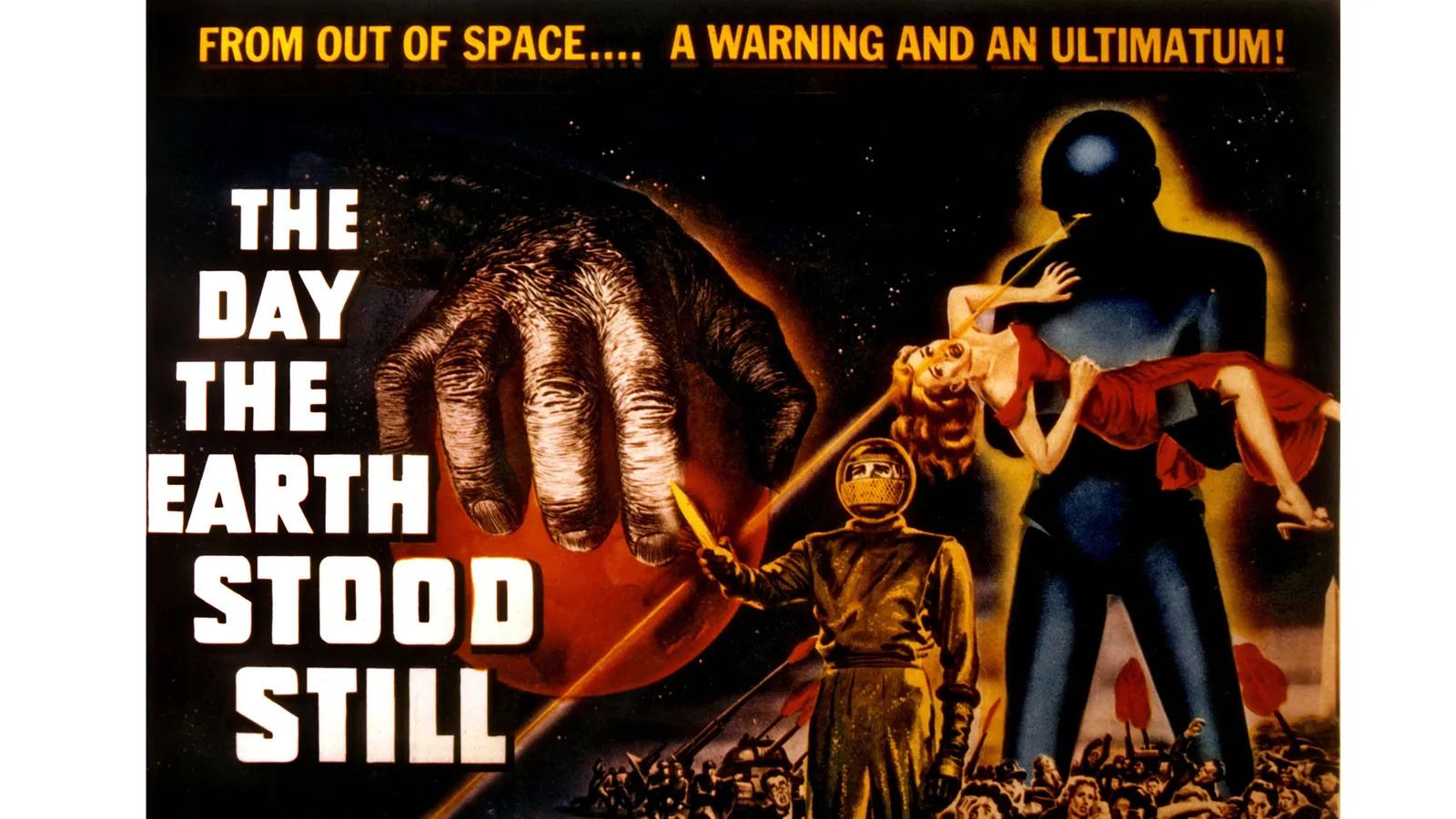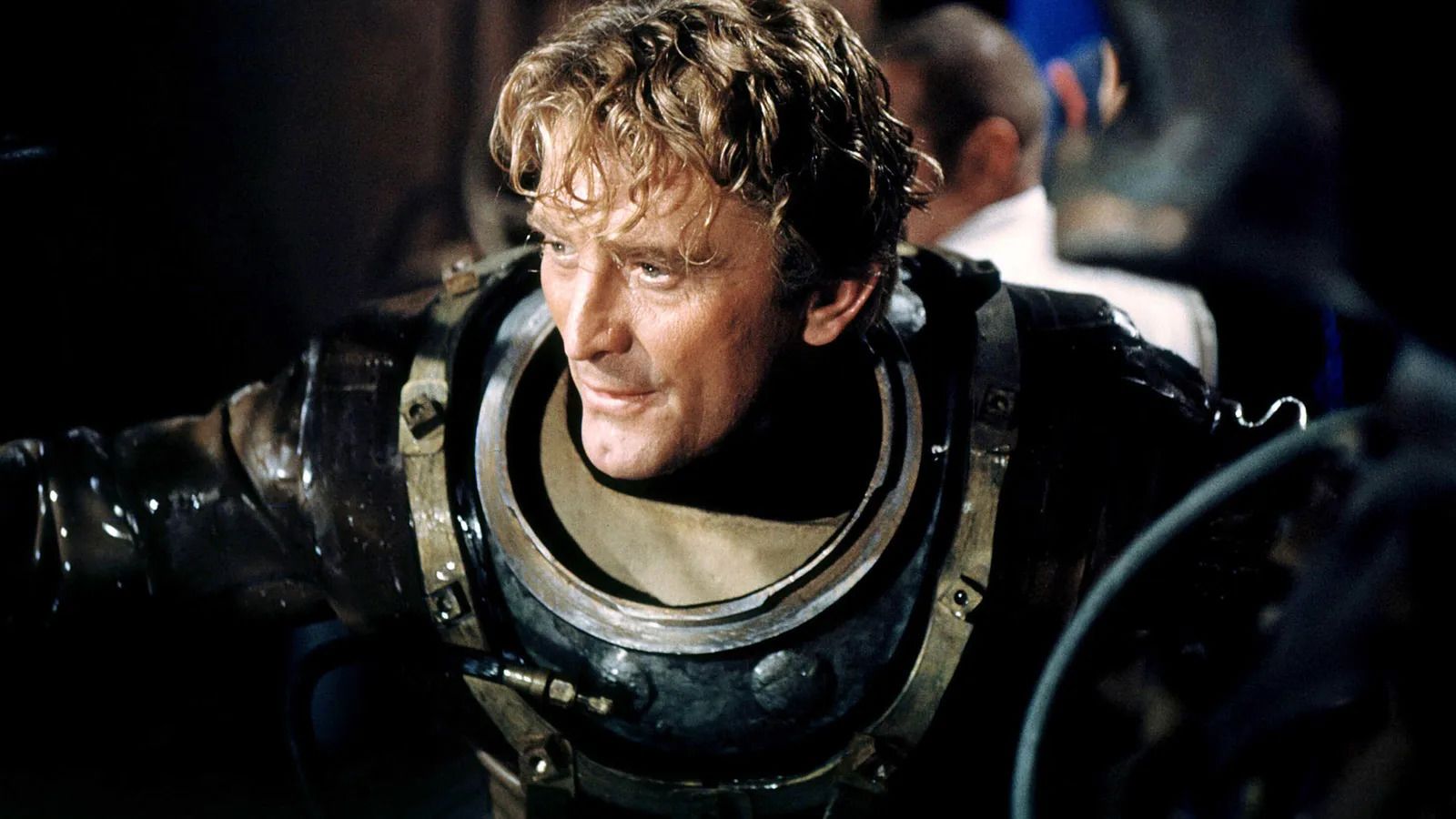
The UFO sightings that swept the US
It's only there for a moment in the trailer for Jordan Peele's new horror film, Nope, but it's definitely there: a flying saucer. Judging by the twists and turns in Peele's previous films, Get Out and Us, it's impossible to say whether its real or fake, whether it's from the Earth or from outer space, but that glimpse of sparkling silver is tantalising. Maybe, just maybe, Nope will be a proper flying-saucer movie – a celebration of one of the most recognisable and spine-tingling shapes in the history of popular culture.
"By the end of the 1950s," says Andrew Shail, senior lecturer in film at Newcastle University, "that particular shape had become a shorthand for 'spacecraft piloted by beings from another world', available to everyone working in the visual arts." Sure enough, flying saucers have signified mysterious visitors from Mars and beyond in countless films, TV series, novels, comics, and even hit records, from Mulder's I Want To Believe poster in The X-Files TV series to the popular children's picture book, Aliens Love Underpants. The flying saucer is a design classic – the archetypal Unidentified Flying Object. And yet it didn't take off, so to speak, until the 1950s, when the world went flying-saucer crazy.
Science-fiction artists had drawn circular spacecraft long before that: an early Flash Gordon strip from 1934 features a spinning "squadron of deadly space-gyros". But if you flick through copies of Startling Stories, Super Science Stories and other pulp magazines of the period, you'll see that in the first half of the 20th Century, aliens preferred their transport to resemble submarines and airships.
 A UFO or flying saucer appears in the trailer for Jordan Peele's latest
film, Nope, which is released on 22 July and stars Daniel Kaluuya
A UFO or flying saucer appears in the trailer for Jordan Peele's latest
film, Nope, which is released on 22 July and stars Daniel Kaluuya
That all changed 75 years ago. In June 1947, a commercial pilot, Kenneth Arnold, claimed to have seen nine "flying discs" zipping across Washington state in the US at 1,200 mph. The editor of the East Oregonian newspaper sent this utterly unverifiable story to the Associated Press news service, and on 26 June, Hearst International put out a press release that contained the fateful term "flying saucers". The story spread around the globe considerably faster than 1,200 mph. Soon there were hundreds of other reported sightings – including one of crashed flying-saucer debris in Roswell, New Mexico. Some of these reports were clearly hoaxes: it wasn't hard to fake a saucer photograph if you had a hubcap, frisbee or pizza to hand. Some sightings, says Shail, were of "weather balloons, Zeppelins, cloud formations and experimental aircraft being developed by the US Air Force as part of the Cold War". And, just to be open-minded about it, perhaps some of the sightings were of Martians who were hovering over sparsely populated parts of the Earth for the fun of it. But one thing was certain: saucer-mania had begun.
Interest in flying saucers shot up around the same moment it became plausible that humans would visit space – Katharine Coldiron
In 1953, Donald H Menzel's book on this hysteria, Flying Saucers, offered three explanations. "First, flying saucers are unusual. All of us are used to regularity. We naturally attribute mystery to the unusual. Second, we are all nervous. We live in a world that has suddenly become hostile. We have unleashed forces we cannot control; many persons fear we are heading towards a war that will destroy us. Third, people are enjoying this fright to some extent. They seem to be a part of an exciting piece of science fiction."
 Seventy-five years ago, in July 1947, crashed flying-saucer debris was found in Roswell, New Mexico
Seventy-five years ago, in July 1947, crashed flying-saucer debris was found in Roswell, New Mexico
The nervousness Menzel mentions had several causes. One was that the US and the USSR were competing to be the first superpower to put a satellite into orbit: the USSR won with Sputnik 1 in 1957. "Interest in flying saucers shot up around the same moment it became plausible that humans would visit space," says Katharine Coldiron, the author of the Midnight Movies Monograph guide to one notoriously terrible saucer movie, Plan 9 from Outer Space. "The human imagination spirals out in all sorts of directions when something like the space race radically stimulates it. I think we're seeing the same thing happen with climate change – creators of all kinds have been stimulated to make art about the possible end of our species, and, in fiction at least, we're just seeing that wave gain critical mass."
Americans had other things to worry about, too: unemployment, inflation, the threat of a Soviet invasion, and, especially, the possibility that their own cities might be razed by the kind of atomic bombs that had devastated Hiroshima and Nagasaki in 1945. One way of sublimating all that fear was to focus on flying saucers, "a phenomenon that was mysterious and entertaining," Jack Womack, an award-winning science-fiction author, tells BBC Culture, "but not necessarily threatening, unlike the possibility of nuclear war".
Flying saucers in popular culture
Almost as remarkable as all the saucer sightings was the fact that so many people wrote memoirs about them. Womack's collection of these memoirs is the subject of his book, Flying Saucers Are Real!, which includes excerpts from Those Sexy Saucer People, Flying Saucers and the Scriptures, and Round Trip To Hell in a Flying Saucer. One choice example is George W Van Tassel's I Rode a Flying Saucer, which was published in 1952. "He is honest enough to note that he didn't actually ride a flying saucer," says Womack, "but the space brothers suggested that he give his work a more marketable title." As ludicrous as many of these supposedly non-fiction books were, though, there were some learned theses among them. Carl Jung, the Swiss psychiatrist, pondered the topic in Flying Saucers: A Modern Myth of Things Seen in the Sky, published in 1959.
By this time, flying saucers had flown all the way through popular culture. Comics, unsurprisingly, were bursting with saucers. One special issue of EC Comics' Weird Science-Fantasy in 1954 boasted: "EC Challenges The US Air Force With This Illustrated, Factual Flying Saucer Report." In the world of animation, Chuck Jones's Bugs Bunny cartoon, Haredevil Hare, introduced Marvin the Martian in 1948. He was piloting a Buck Rogers-style rocket ship on this occasion, but when Marvin visited Bugs on Earth in The Hasty Hare in 1952, he had traded up to a flying saucer.
 The first flying-saucer picture was a low-budget independent called The Flying Saucer (1950)
The first flying-saucer picture was a low-budget independent called The Flying Saucer (1950)
In 1951, Ella Fitzgerald recorded a jazzy number written by Arthur Pitt and Elaine Wise called Two Little Men in a Flying Saucer, a satirical catalogue of humanity's off-putting habits, as seen by the little green men of the title: "During their mission / Heard a politician / Making speeches as they travelled by / But they departed / Faster than they started / Because the hot air blew them sky high." (The song has since been simplified into a nursery-school counting song.) But no medium was more besotted by flying saucers than cinema.
The first flying saucer film, called, yes, The Flying Saucer, came out in 1950. This was a low-budget independent thriller written, directed and produced by its star, Mikel Conrad, and marketed with the suggestion that it might be based on the truth. "What are they?," asked a poster's slogan. "Where are they from? Have you seen a flying saucer?" In the following year, 1951, Hollywood released two bona fide saucer classics. One was Robert Wise's The Day the Earth Stood Still, in which an alien ambassador named Klaatu (Michael Rennie) warns the human race to "live in peace, or pursue your present course and face obliteration". His smooth, windowless saucer is the last word in interplanetary minimalism. The other 1951 classic was Howard Hawks' The Thing from Another World, in which an alien spaceship is recovered from the Arctic ice. In the source material, a short story by John W Campbell, the spaceship is "like a submarine... 280 ft long and 45 ft in diameter", but in the film it's a saucer – and its one surviving crewmember is a monstrous predator. "In their own way, each of these films embodied the dark undercurrent of social paranoia that besieged America," writes Michael Stein in Alien Invasions! The History of Aliens in Pop Culture. "One evoked the fear of subversive invasion, the other addressed the nightmare of global destruction."
 Hollywood released two classic saucer films in 1951 – Robert Wise's The
Day the Earth Stood Still and Howard Hawks' The Thing from Another World
Hollywood released two classic saucer films in 1951 – Robert Wise's The
Day the Earth Stood Still and Howard Hawks' The Thing from Another World
Considering how regularly flying saucers have been substitutes for more earthbound terrors, it will be fascinating to see what they represent in Nope. So far, Peele's ingenious horror movies have been cutting social commentaries, with an emphasis on the racism endured by black Americans. Will Nope continue this trend? "Peele's decision to make a UFO movie is unsurprising," says Mark Bould, the author of the Routledge Film Guidebook to Science Fiction, "because there has always been a racial element to accounts of flying saucers and alien abduction. In the late 1940s, the aliens were often described as exaggeratedly, excessively white people. African Americans are the descendants of abductees, the victims of technologically advanced pallid aliens who suddenly appeared from far away, and African-American science fiction and Afrofuturism frequently return to this brutal historical rupture. Nope is just the latest example to make this mothership connection."
The end of saucer-mania
Back in the 1950s, flying saucer films didn’t always have such profound socio-political concerns. They included Devil Girl from Mars (1954), This Island Earth (1955), Forbidden Planet (1956), Invasion of the Saucer-Men (1957) and The Atomic Submarine (1959). One of the greatest was Earth Vs The Flying Saucers (1956), with typically fabulous stop-motion animation by Ray Harryhausen. One of the not-so-greatest was the aforementioned Plan 9 From Outer Space (1957).
 One of the greatest 1950s flying-saucer films was Earth Vs The Flying
Saucers (1956), with stop-motion animation by Ray Harryhausen
One of the greatest 1950s flying-saucer films was Earth Vs The Flying
Saucers (1956), with stop-motion animation by Ray Harryhausen
What they all had in common was the saucer. From a filmmaker's perspective, this iconic spacecraft was a godsend, in that it was relatively easy to construct and shoot. Unlike a traditional rocket, it could switch direction without any need to show it turning around. It also looked fantastic.
The flying saucer appears in an era of secretive new technologies, primarily military, including the atomic bomb… but also a flood of new domestic consumer technologies – Mark Bould
"The great thing about flying saucer design is that it is simple to the point of abstraction," Bould tells BBC Culture. "Its perfect symmetry insists that it is not some naturally occurring thing, while the absence of familiar signifiers of flight – no wings, no engines – insists that it must be not only a technological artefact but an incredibly advanced one. It asserts its place far ahead of us in the western mythology of progress."
Not that the saucer was entirely other-worldly. Its shiny curved surface, behind which lurked all sorts of complicated wires and valves, reflected the most fashionable cars, ovens, and washing machines of the post-war period. "The flying saucer appears in an era of secretive new technologies, primarily military, including the atomic bomb," Bould tells BBC Culture, "but also a flood of new domestic consumer technologies, the inner workings of which become increasingly mysterious to the average householder. The flying saucer seems to incorporate both tendencies, writ large across American skies."
 The big sci-fi hit of the 1950s was not an alien invasion movie, it was Disney's 20,000 Leagues Under the Sea
The big sci-fi hit of the 1950s was not an alien invasion movie, it was Disney's 20,000 Leagues Under the Sea
The flight didn't last for long. As the 1950s came to an end, saucer-mania waned, both in terms of reported sightings, and silver-screen appearances. "When it came to flying saucer movies, the horror ones did better than the serious ones," says Mark Jancovich, the author of Rational Fears: American Horror Genre in the 1950s. "And you could make the horror ones quite cheaply. What happened was that science-fiction horror moved into the cheap, low-budget end of the market. Studios also recognised that the really big sci-fi hit of the 1950s was not an alien invasion movie, it was Disney's 20,000 Leagues Under the Sea. You then got this wave of period sci-fi films like The Time Machine, The Curse of Frankenstein and The Lost World [starring Klaatu himself, Michael Rennie]. The Victorian settings of gothic horror films made them seem respectable, whereas flying saucers moved downmarket as the 1950s went on."
Meanwhile, in the real world, 1961 was the year when Yuri Gagarin orbited the planet, and President John F Kennedy announced the goal of "landing a man on the Moon and returning him safely to the Earth". Actual space travel was so astounding that flying saucers seemed quaint in comparison. Finally, in 1969, the US Air Force's survey of saucer sightings, Project Blue Book, closed with the publication of a Scientific Study of Unidentified Flying Objects. Its damning conclusion: "Nothing has come from the study of UFOs in the past 21 years that has added to scientific knowledge".
Of course, people kept reporting UFO sightings in the 1960s and beyond. This very May, there was an American public congressional hearing on what are now known as UAPs – Unexplained Aerial Phenomena – although Scott Bray, the deputy director of naval intelligence, stressed that the military hadn't found "anything non-terrestrial in origin". You could argue that in popular culture, too, flying saucers have never really gone away. Super-size a flying saucer and you get the motherships in Independence Day and District 9; flip it on its side and you get the looming monoliths in Arrival. In Star Wars, the Millennium Falcon is a flying saucer with some extra pointy bits poking out of the front; and in Star Trek, the USS Enterprise is a flying saucer with a body and legs stuck on the back. But sightings of old school, unadorned flying saucers, in the sky or on the screen, are now rare. "Like any fad," says Womack, "the phenomenon in its original form simply ran its course."
Today, flying saucers are a piece of quintessential 1950s Americana to file alongside a roadside diner's chequerboard floor and the tail fins of a gas-guzzling convertible. When they're used in modern science-fiction blockbusters, such as Men in Black and Tim Burton's Mars Attacks!, it's because of that vintage quality. Maybe that's how Jordan Peele will use them, too, sensitive as he is to America's historic injustices. Once the flying saucer seemed to have hurtled down from the frightening future; now it's a relic of the comforting past.